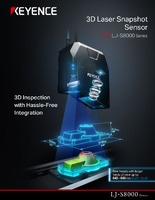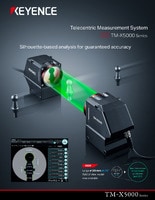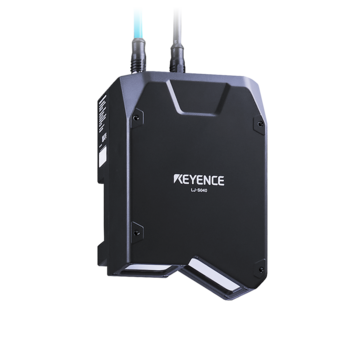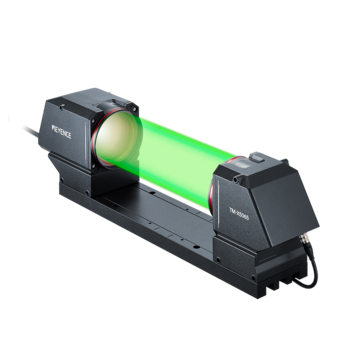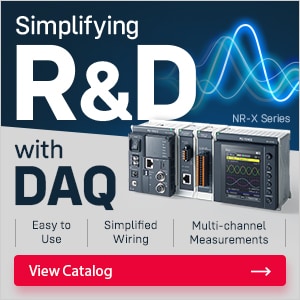Measurement Sensors
Dimension Measurement
Displacement Measurement
Measurement Sensors for the Aerospace Industry
Aerospace manufacturing relies on aircraft sensors to ensure safety, precision, and regulatory compliance. These sensors are crucial in manufacturing aircraft components as they make sure every part meets strict quality standards.
Why Aerospace Sensors Are Critical for Quality Control
They are engineered to detect minute defects with accuracy, minimizing the risk of faulty components. Sensors also maintain reliability across production processes by monitoring clean environments and safeguarding sensitive parts.
Rigorous testing and measurement further ensure that each part adheres to industry standards. Advanced testing methods simulate real-world operational conditions, which verifies that components can withstand extreme environments.
From avionics to control systems, sensors guarantee that only the highest-quality components make it off the production line and into the aerospace industry.
Key Measurement Applications in Aerospace
Advanced aerospace sensors and testing methods are essential to every stage of production in aerospace applications. Aerospace manufacturing sets the bar for precise measurement tools to ensure the reliability of components.
Temperature sensors monitor critical systems to ensure they operate within safe temperature ranges. By identifying overheating risks or inefficiencies during testing, these sensors help prevent component failures and maintain operational reliability.
Force and torque sensors assess the structural integrity of a component and measure the loads they endure. These sensors are very important to safety, particularly when it comes to aircraft components like wings and landing gear. These tools also verify that rotating parts, such as those in aircraft engines, are securely assembled. They are particularly important to make sure components can withstand the stress they will endure while in use.
Similarly, non-destructive testing evaluates components under simulated conditions. Typically, these are extreme conditions that an aircraft would experience. These include high temperatures or vibrations. Techniques like ultrasonic and X-ray testing are able to detect defects without damaging materials. This helps ensure the parts meet industry requirements and safety specifications.
Discover more about this product.
Click here to book your demo.

Ensuring Precision in Aircraft and Engine Part Inspection
AI-powered vision systems have revolutionized in-line aircraft engine part inspection; they process high-resolution images in real time and utilize advanced algorithms to look for defects. This helps minimize human error and ensures that only defect-free components advance through production.
In addition to vision systems, modern inspection processes incorporate computational tools like advanced metrology systems and simulations. These help capture 3D data, which gives manufacturers the ability to inspect complex geometries with micro-level accuracy. Simulations can be conducted to further refine this process by offering insights into how each component behaves when in use. If a specific part is constantly failing or running into issues, it can be redesigned for optimal performance.
For large-scale aerostructures, like wings and fuselage sections, there is a huge benefit from non-contact measurement techniques; meaning, high-speed optical scanners capture precise measurements without physical contact. This allows for efficient and accurate inspections of these huge components without the risk of human error.
These systems streamline production while also maintaining quality. Each piece of an aircraft must meet very specific metrics to prevent potential danger to passengers and airline employees. With these systems and tools, tragedy can be avoided.
Aerospace Component Quality Control
Aerospace sensors are needed to maintain quality control across all stages of a component's lifecycle while in production. Vibration and temperature monitors detect early signs of wear or stress in key systems. These sensors analyze factors such as thermal behavior which helps validate performance and prevent failures. This is especially important in critical systems, such as aircraft engine part inspection and aerospace part inspection. This constant monitoring helps guarantee reliable products and compliance with industry standards.
Real-time data from these aircraft sensors has transformed the production process by enabling predictive maintenance to replace common reactive approaches. By being proactive, these measures help improve efficiency and allow operators to spend more time on other tasks.
Despite the benefits, these sensors face their own challenges. For example, over time, sensors may lose their accuracy and require additional adjusting. Eventually, they will need to be replaced. Thankfully, innovations like AI-driven analytics help address these issues, and these sensors are always improving.
Are you ready to achieve new heights? KEYENCE can deliver top-of-the-line quality assurance solutions, and our aerospace sensors are the perfect addition to any production line. If you’re ready to explore our quality assurance options, contact KEYENCE today.
Contact us to learn more about how our advanced technology can help take your business to the next level.
Contact Us
Related Products
Applications
Dimension Measurement
- Thickness and Width Measurement
- Step Height Measurement
- Inner and Outer Diameter Measurement
- Measuring Angles
- Meandering/Edge Measurement
Displacement Measurement
- Positioning and Stroke Length Measurement
- Vibration and Runout Measurement
- Deflection Measurement
- Measuring Eccentricity

